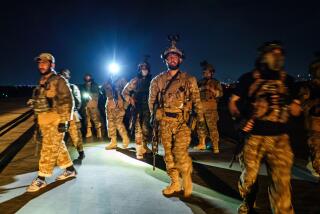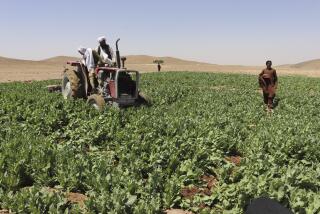Marines launch offensive in southern Afghanistan town
- Share via
Reporting from Kabul, Afghanistan, and The Outskirts Of Marja, Afghanistan -- Thousands of U.S., British and Afghan troops moved to seize the Taliban stronghold of Marja early Saturday in what the Marine general leading the assault called a “big, strong and fast” offensive aimed at challenging the insurgency’s grip on a key southern Afghan province.
Rounds of tracer fire lighted up a starry, predawn sky as waves of troops, ferried in by helicopters, descended on the farming districts that surround the town. Transport and Cobra attack helicopters also dropped flares to illuminate the ground.
As dawn broke, ground troops moving toward the town carried out painstaking compound-by-compound searches, looking for insurgents who might have tried to hide among farm families.
Marine commanders said their troops encountered “minimal resistance” -- mainly sporadic small-arms fire -- and there were no battlefield injuries in the first hours of the assault.
Sporadic firefights had broken out throughout the day Friday on the periphery of Marja as Marine units probed Taliban defenses.
The commander, Marine Brig. Gen. Larry Nicholson, had for weeks telegraphed the military’s plans for the offensive, one of the largest since the war began in 2001.
The United States and its allies hope the assault, the biggest joint operation by Western and Afghan troops to date, will prove to be a turning point in the conflict with the Taliban and other militants who have carved out swaths of territory in Afghanistan.
Military leaders expected about 7,500 coalition troops to occupy Marja by nightfall, with 7,500 more supporting the mission from elsewhere in the Nad Ali district of Helmand province.
Marines, led by battalions from Camp Pendleton in California, Camp Lejeune, N.C., and Kaneohe Bay, Hawaii, attacked from multiple directions in an effort to confuse and overwhelm Taliban fighters. Each Marine battalion was paired with an Afghan battalion.
The offensive is seen as a test both of the fighting spirit of the Afghan army and the ability of the government of President Hamid Karzai -- with the help of NATO forces and a large corps of civilian workers -- to quickly establish a working government in Marja, a town of about 85,000. As many as 1,000 Taliban and other insurgents took refuge in the town after being driven from a string of villages elsewhere in the Helmand River Valley.
The assault is the first major operation involving U.S. forces since President Obama’s decision late last year to deploy an additional 30,000 troops to Afghanistan. The buildup is part of an effort to turn the tide of the war before an American drawdown that is set to begin next year.
Officials also believe that a series of military gains could make it easier to woo fighters away from Taliban ranks.
Karzai’s government wants to take it a step further and try to bring the Taliban leadership to the bargaining table, but the Obama administration does not believe figures such as Taliban chief Mullah Mohammed Omar are “reconcilable.”
With a battlefield that is also home to tens of thousands of civilians, leaflets were dropped by helicopter days before the offensive asking residents to leave, and tribal elders were enlisted to spread the word about the upcoming assault. Though hundreds of families fled, thousands more hunkered down in homes and on farms.
Tribal elders made last-minute pleas for troops to refrain from firing on compounds where insurgents were holed up, saying residents were afraid to turn away Taliban who commandeered their homes.
Nicholson, who has branded Taliban control of Marja a “cancer,” said he expected major objectives -- control of intersections and key buildings and elimination of Taliban fighting positions -- to be accomplished by nightfall. Marines were to distribute small radios so residents could hear Afghan politicians endorsing the mission.
“Marja is a place of fear, panic and terrorism,” Brig. Gen. Mahayoodin Ghoori, the Afghan battlefield commander, said before the offensive. “The people are tired of the people controlling Marja. We are returning the people to their normal life.”
The Taliban boasted before the assault that its fighters would hold their ground. But for tactical reasons, the insurgents often avoid head-on confrontation with the vastly better armed Western forces, instead slipping away, staging hit-and-run attacks and regrouping.
Although clashes with militants positioned in buildings, irrigation canals and trenches were expected, the major threat to U.S. and allied troops appeared to be hundreds, perhaps thousands, of buried roadside bombs. Officials say the Marja battleground represents the largest, most complex concentration of the so-called improvised explosive devices encountered by North Atlantic Treaty Organization troops. Essentially, they say, all approaches to the town form a giant minefield.
To counter the tangle of bombs, the Marines have five 70-ton Assault Breacher Vehicles they intend to use to roll through roads ahead of the ground troops, which will follow the initial airborne assault. Each vehicle can fire line charges, laden with thousands of pounds of explosives, to detonate buried bombs. Marja is considered the last urban stronghold of the Taliban in the south-central province of Helmand, where the insurgency has been largely unchecked in recent years despite the efforts of British forces.
Last summer, battalions of Marines began wresting control of villages in the fertile Helmand River Valley from militants. After several weeks of fighting, many of the insurgents fled to Marja.
Marines refrained from chasing them at the time because they lacked the manpower to establish a long-term presence, a key element of the current offensive.
Helmand and adjacent Kandahar province are considered the heartland of the Taliban movement. In Helmand, Western officials say, insurgents have been able to control the illicit poppy crop, used in heroin production, which funnels an estimated $500 million a year into Taliban coffers. Moreover, the province is a major infiltration route for militants and weapons arriving from Pakistan.
One objective of the Marja assault, officials said, is to arrest members of the Taliban involved in the drug trade and destroy their laboratories. Afghan drug police have lists of suspects and are set to conduct house-to-house searches for them.
In previous offensives in Helmand, the Afghan army mustered only a few hundred soldiers, and their performance was spotty. U.S. and Afghan generals said the Marja mission would showcase Afghan troops’ fighting ability.
“The whole international community is watching us now,” said Afghan Brig. Gen. Sher Muhammad Zazai.
Though the Marines are in the lead, each unit is partnered with an Afghan unit. In addition, U.S. Army Special Forces are teamed up with Afghan commandos.
Within days of the troops’ arrival, officials say, the basic mechanisms of government are to be in place. An Afghan administrator for the town has already been named. U.S. civilian agencies are ready to open offices. Nicholson has ordered each of his commanders to begin meeting immediately with Marja’s elders to determine community needs.
Commanders anticipated that the Taliban would try to engage troops in ways that put civilians in the line of fire. The insurgents often make use of civilian casualties to inflame sentiment against foreign troops.
More to Read
Sign up for Essential California
The most important California stories and recommendations in your inbox every morning.
You may occasionally receive promotional content from the Los Angeles Times.










